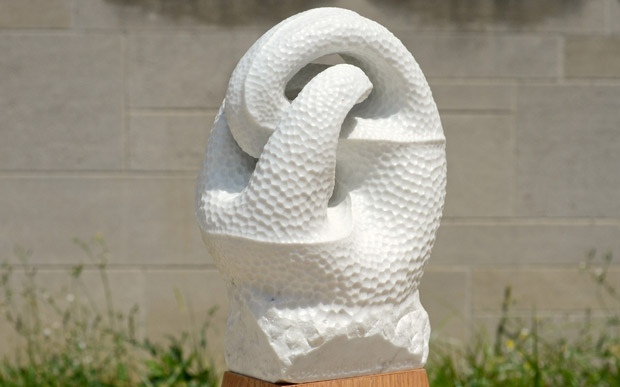The Department of Mathematics is pleased to have and share this sculpture by artist and mathematician Helaman Ferguson.
The Figure Eight Knot Complement III, 1992, is direct-carved in white Carrara marble, with a honeycomb texture and esker (raised ridge). It measures 14′′×11′′×7′′ and weighs approximately 60 lbs.
This piece was acquired by the department directly from the sculptor in 1994 using funds collected in memory of Radu Tudorica, a talented math major who died before graduating. It is on display in the department's conference room.
Ferguson has been both a research mathematician and a sculptor. He received his Ph.D. in mathematics from the University of Washington in 1971 and served for 17 years on the mathematics faculty of Brigham Young University before becoming a full-time artist. He lives and works in Maryland.
Figure Eight Complement III is featured on pages 46-47 of the book HELAMAN FERGUSON: Mathematics in Stone and Bronze [Meridian Creative Group, Erie, Pennsylvania, 1994] by Claire Ferguson. We quote Figure Eight Complement III is a linked double torus, its two handles intertwined in an eternal embrace. A figure eight knot, superimposed on the double torus as an esker curve, encircles the handles but bounds only one surface. Swan-like handles perform a delicate white pas de deux as the linking thrusts through itself.
As the name indicates this piece is one of a series of investigations of the figure eight knot. Version I is a much smaller piece out of red alabaster. Version II is much larger, also out of white Carrara marble. It is 34 inches tall, weighs some 600 lbs, and is installed in a public area of the Williston Library at Mount Holyoke College.
Speaking purely mathematically, it has been shown that the complement of the figure eight knot in the 3-sphere admits a Riemannian metric of constant curvature -1 and hence is expressible as a quotient of non-Euclidean hyperbolic 3-space H3 by a discrete group of isometries, or rigid motions. In this case it turns out that G is a subgroup of index 12 in the so-called Bianchi group {\rm PSL}_2({\mathbb Z}[\omega]), where \omega = e^{2 \pi i/3} is a primitive third root of unity.
Much of this latter information is carved into the marble base of the sculpture. The sculpture itself does not actually represent the entire knot complement directly. The abstract knot bounds a non-orientable surface with two holes (i.e., a punctured Klein bottle). The space of this sculpture represents a thickening of this surface into a 3-dimensional, self-linking, object with two holes on which the original knot can be traced.
It is interesting to compare this with the description of Figure Eight Complement II at Mount Holyoke. In that case the figure eight knot is described as separating the two-hole torus into two separate portions. It is based on a thickening of a punctured torus that the figure eight knot also bounds.- Allan Edmonds

 The College of Arts
The College of Arts